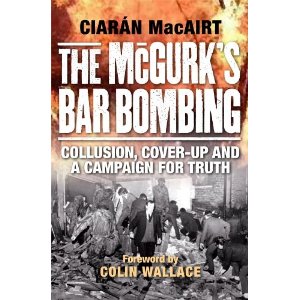 “On the night of Saturday, 4th December 1971, along with the other internees in Cage 3 at Long Kesh, I heard the awful news about the murderous attack on McGurk’s Bar. Within the Kesh then, there were many internees from North Belfast, and the tension as we tried to find out if any of our loved-ones were among the dead and injured crackled in the air like static electricity.”
“On the night of Saturday, 4th December 1971, along with the other internees in Cage 3 at Long Kesh, I heard the awful news about the murderous attack on McGurk’s Bar. Within the Kesh then, there were many internees from North Belfast, and the tension as we tried to find out if any of our loved-ones were among the dead and injured crackled in the air like static electricity.”
Veteran republican Gerry O’Hare reviews a new book by Ciarán MacAirt whose grandmother, Kitty Irvine, was one of those murdered in the McGurk’s Bar Massacre:
All through that awful night, we listened intently to the radio for news. The screws refused to speak to us as we were all locked-up at the time. Dawn broke, and still we internees gathered round our radios for news that, agonizingly, did not come with any great detail.
At 8am, the doors to the huts were opened and men trundled out and called to others in Cages One and Two for possible information.
Imagine our feelings when news broadcasts hinted it was an IRA “Own Goal”.
We were shattered, disconsolate that the IRA, according to the reports, was responsible. Men could not look each other in the eyes.
The wait for news of relatives and neighbours dragged on.
A priest, who arrived to say Mass, had scant details. He only knew how many were dead and injured – not their names. As for the “Own Goal” theory, he could neither confirm nor deny.
However, towards tea time on the Sunday, news reaching us from the Belfast Brigade denied the “Own Goal” and squarely put the blame on loyalists. For a few weeks coming up to Christmas, a propaganda war took centre stage, as the fifteen who died were buried while the survivors fought for their lives.
The Brits and RUC took a perverse delight, knowing it was a loyalist attack, and heaping lies to keep the IRA under extreme pressure from its own community.
The families of the atrocity now have an excellent book written by the grandson of Kitty Irvine, who died in the attack. It correctly apportions blame to loyalists and exposes the dirty tactics of the establishment.
Ciarán’s story and research not only nails the lie about those who were murdered at McGurk’s but also holds to account those responsible.
The gruesome details of the suffering that the dying had to endure make for harrowing reading. I had to put the book down on occasions, so upsetting are the accounts of death and injuries.
The author believes one reason for the attack on McGurk’s Bar was to create deadly divisions between the Official and the Provisional IRA. McGurk’s, he believes, was not the intended target that night. The nearby Gem Bar, frequented by Officials was. The UVF, so the theory goes, reasoned that internecine war would break out as the Officials sought revenge by attacking the Provisionals and then the Provisionals would counter attack. It would also drive a serious wedge between people living in the community. He refers to a statement made by the only person ever to be charged and sentenced for McGurk’s, Robert James Campbell.
In his one-and-a-half page statement, taken by the RUC, Campbell briefly states that he was approached by the local UVF commander on the Shankill to join two other members and carry out the operation, initially for the Gem Bar. What is even more unbelievable is that Campbell’s statement was so short. One-and-a-half pages for fifteen lives lost and others shattered?
This, of course, suited the RUC and their lamentable failure to get to the truth. Truth is, of course, the RUC were quite aware of the truth and were determined to make sure that nobody, particularly the families, ever got to it.
A car found some 300 yards from the bar was quickly established to have been the murder gang’s vehicle. It was given a cursory and derisory examination and it then disappeared from the face of the earth. So much for impartial RUC investigations.
Ciaran then takes us on a history of the conflict, from the outset, from the time the Civil Rights Movement was formed and its demands and actions. He outlines the reasons for internment, the Unionist Party’s insistence on its implementation, and the weakness of the Heath government in bowing to Brian Faulkner and John Taylor (Prime Minster and Home Affairs Ministers in the Stormont administration).
Again and again, one feels anger at the way the Brits capitulated to Stormont.
We learn how the unionists succeeded in ensuring that loyalists were excluded from the round-ups despite the authorities being aware of their continuing murderous slaughter of Catholics in their homes.
Ciaran’s diligence and massive research is a credit to his determination to expose the lies and criminal actions of the RUC and British Army. Indeed, he succeeds in getting the leading British Army propagandist of the day, Colin Wallace, to write a foreword to the book.
Again it is shocking and confirms the credibility of Colin research.
The history of the McGurk’s atrocity was one of the foulest attacks on the nationalist/Catholic community at that time.
Ciarán will be available to sign copies of his book and answer any questions at an event in Clifton House, Belfast, on 15th November at 7pm.
The McGurk’s Bar Bombing: Collusion, Cover-Up and the Search for Truth by Ciarán MacAirt (with a foreword by Colin Wallace), Frontline Noir, pp244, £9.99.



